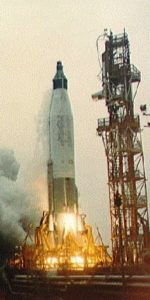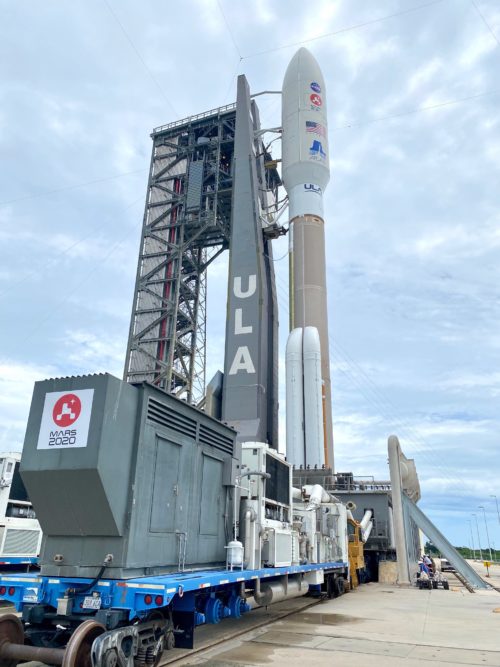
United Launch Alliance (ULA) stands ready to deliver NASA’s long-awaited Perseverance rover to Mars, having smoothly rolled out a giant Atlas V to historic Space Launch Complex (SLC)-41 at Cape Canaveral Air Force Station, Fla. The 197-foot-tall (60-meter) rocket—flying in its “541” configuration with a 17-foot-diameter (5-meter) payload fairing, four solid-fueled boosters and a single-engine Centaur upper stage—was carried the 1,800-foot (550-meter) distance from the Vertical Integration Facility (VIF) to the pad on Tuesday morning, atop the Mobile Launch Platform (MLP). Nicknamed “The Dominator” by ULA CEO Tory Bruno, the powerful 541 will certainly dominate much activity and attention in the next two days, as it sets out on America’s next voyage to the Red Planet.
Also early Tuesday, the highly secretive NROL-44 payload for the National Reconnaissance Office was hoisted atop its mammoth Delta IV Heavy booster, preparatory for launch from the Cape’s neighboring SLC-37B no sooner than 26 August
FOLLOW AmericaSpace’s LIVE Launch Tracker coverage HERE
.
Liftoff will occur during a two-hour “window” which opens at 7:50 a.m. EDT Thursday. And thanks to unexpected delays along the way, and what Mr. Bruno described as “clever trajectory design”, this mission promises to fly a pretty nifty 203-day transit to the Red Planet, before it lands the Perseverance rover in geologically-rich Jezero Crater on 18 February 2021.
“Mighty Atlas” has a long heritage of delivering missions to Mars. The workhorse Atlas V previously lofted the Mars Reconnaissance Orbiter in August 2005, the Curiosity rover in November 2011, the Mars Atmosphere and Volatile Evolution (MAVEN) mission in November 2013 and most recently the InSight lander—the first voyage to the Red Planet flown out of Vandenberg Air Force Base, Calif.—in May 2018.
This morning’s rollout comes on the back of weeks, if not years, of preparation for what ULA CEO Tory Bruno described yesterday as “arguably the most sophisticated and in some ways the most exciting” of all the missions his organization has launched to Mars.
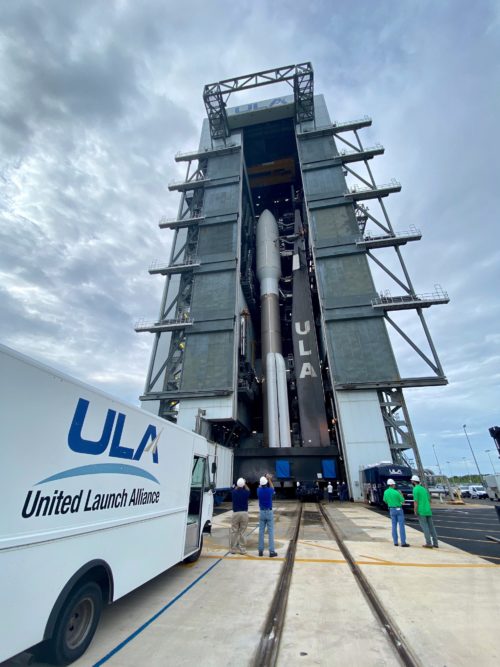
As detailed in AmericaSpace’s Perseverance preview, the mission to land a rover at the site of a suspected ancient Martian lake promises to uncover tantalizing clues about the planet’s watery past, including potential “biosignatures” of past life.
It will also gather a “cache” of soil and rock specimens for a future sample-return mission, perform experimental In-Situ Resource Utilization (ISRU) work to assess the practicalities of generating pure oxygen from Mars’ carbon dioxide-rich atmosphere, examine the nature of the Red Planet’s dust-driven weather and (for the first time on another world) deploy a small helicopter, Ingenuity, to scout ahead of the rover.
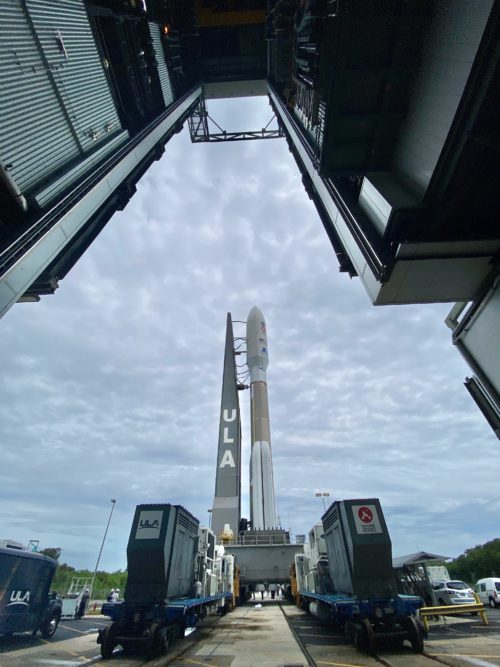
Previously known as “Mars 2020”, the Perseverance mission has been in work for over eight years and draws heavily upon the heritage of its predecessor, the Curiosity rover, which has been exploring Gale Crater since August 2012. But the involvement of ULA in this remarkable voyage officially began in August 2016, when NASA awarded a $243 million contract to the Centennial, Colo.-headquartered launch provider.
In April 2020, the 41-foot-long (12.6-meter) Centaur upper stage arrived at the Cape by road. It will provide two lengthy “burns” of its powerful RL-10C engine to deliver Perseverance firstly into Earth orbit and then onto a trajectory for Mars. A few weeks later, the 107-foot-long (32.6-meter) Common Core Booster (CCB)—the first stage of the Atlas V—also arrived aboard an Antonov An-124-100 airlifter.
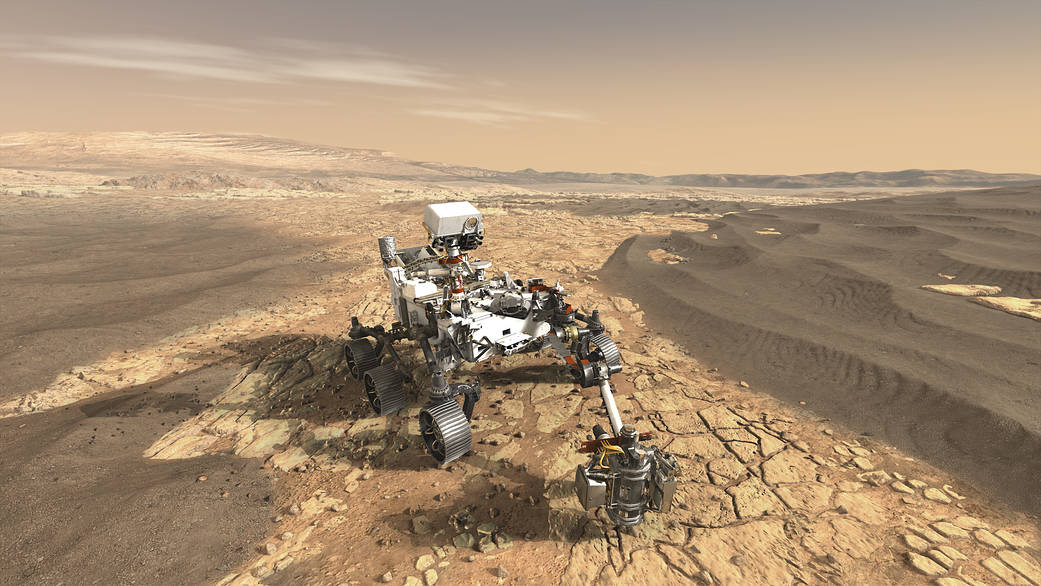
In late May, the milestone Launch Vehicle On Stand (LVOS) milestone took place, when the CCB and Centaur arrived in the VIF at SLC-41 and were raised to the vertical and mated together. The four solid-fueled rocket boosters were installed around the base of the CCB, creating a behemoth which will generate almost 2.4 million pounds (1.1 million kg) of thrust at T-0.
Last month, as is customary for missions with critically narrow “launch windows”, the entire stack—minus Perseverance in its Short Payload Fairing (SPF)—was put through a Wet Dress Rehearsal (WDR), in which the entire countdown was practiced in minute detail. This included loading the booster with 25,000 gallons (113,650 liters) of rocket-grade kerosene (known as “RP-1”) and 66,000 gallons (300,000 liters) of liquid oxygen and hydrogen. At the completion of the WDR, the cryogens were drained, but the RP-1 remained in the CCB tanks through launch day. Finally, the SPF containing Perseverance was hoisted into the VIF and mounted atop the Atlas V on 7 July.
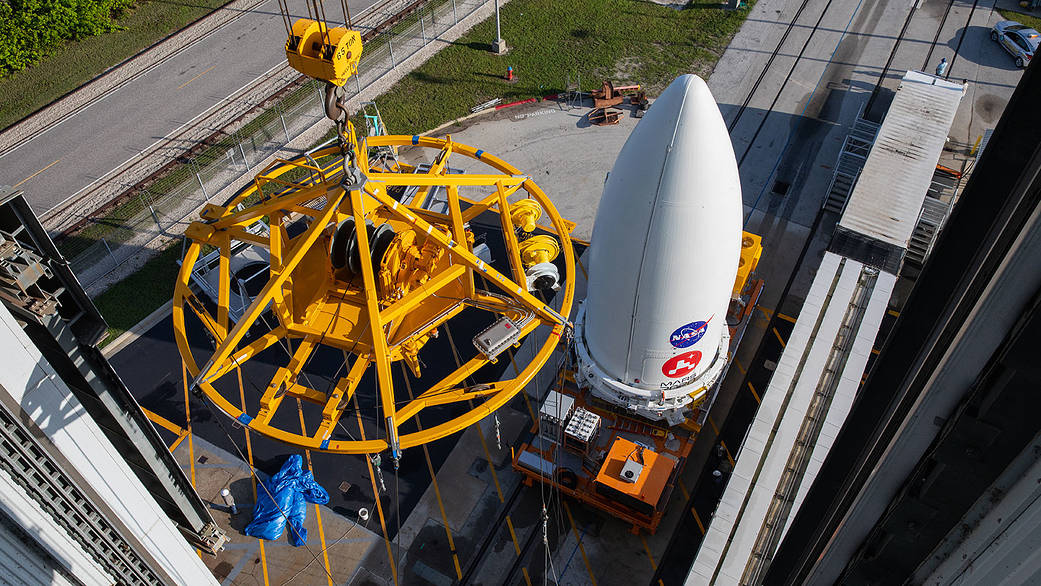
Originally targeted to fly on the 17th, the mission slipped nearly two weeks due to several technical issues, including a crane malfunction and payload contamination concerns. It sailed through a Flight Readiness Review (FRR) last week and a Launch Readiness Review (LRR) on Monday, which gave the definitive go-ahead for rollout from the VIF to the SLC-41 pad surface on Tuesday morning.
An early-morning weather briefing from Launch Weather Officer Jessica Williams of the 45th Weather Squadron verified conditions were acceptable for the rollout. Shortly after 10 a.m. EDT, a readiness check of systems status was completed and ULA Launch Director Bill Cullen authorized the rollout to begin. “First-motion” of the stack got underway at 10:24 a.m., with undercarriage railcars and trackmobile machines pushing the 1.8-million-pound (800,000 kg) vehicle along the 1,800-foot (550-meter) distance from the VIF to the pad surface. Less than 30 minutes later, it passed the pad’s perimeter fence and was confirmed “hard-down” on the pad surface at 11:23 a.m. EDT.
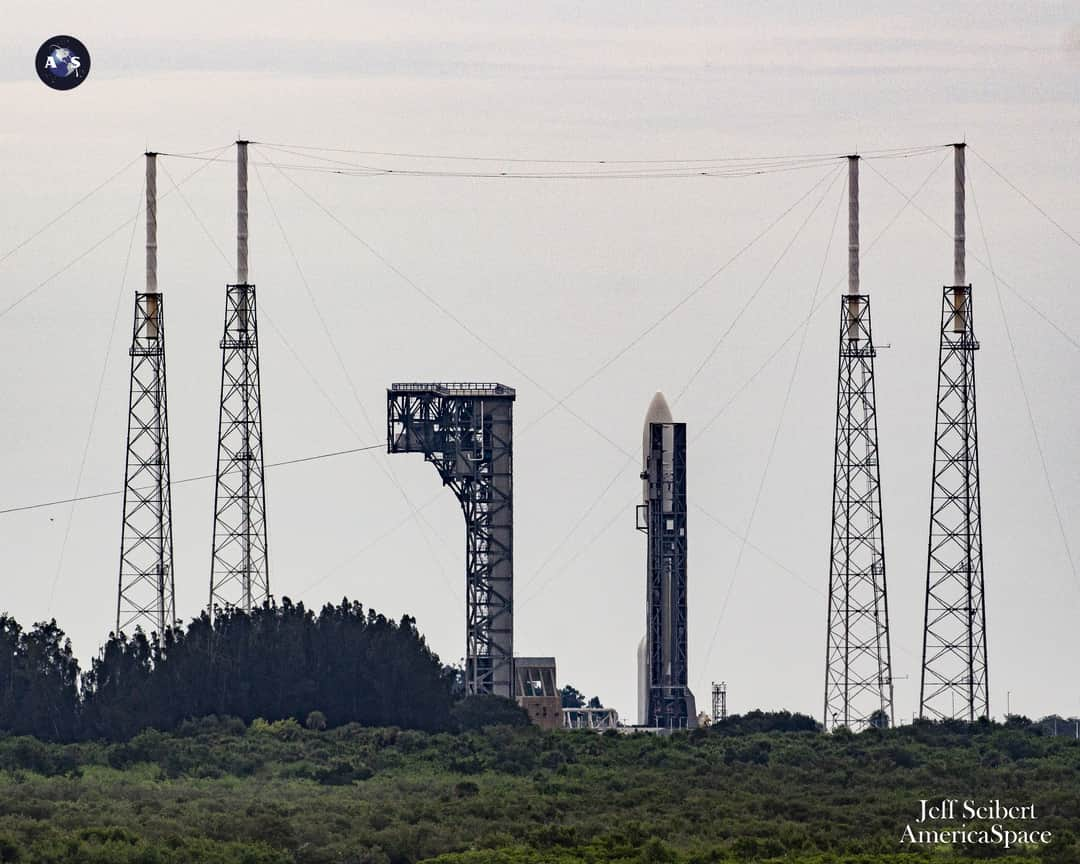
“Over the next few hours today, umbilical connections will be made with launch pad systems,” noted ULA in its rollout blog. “The environmental control system feeding conditioned air to the rocket and payload will be switched to facility supplies to allow the portable trailers used during rollout to be unplugged and moved away. “
Meanwhile, at Space Launch Complex (SLC)-37B, about 3.7 miles (5.9 km) south of the unfolding Perseverance action, efforts to prepare ULA’s fifth flight of the year—the classified NROL-44 mission for the National Reconnaissance Office—are proceeding under a cloak of secrecy with a notably quieter tone. Slated to fly atop a mammoth Delta IV Heavy booster, no earlier than 26 August, Mr. Bruno tweeted early Tuesday that the fully encapsulated NROL-44 payload had been hoisted atop its ride to space. “NROL-44 spacecraft has been successfully mated to the Majestic Delta IV Heavy,” he told the Twitterverse. “On track for her mission.”
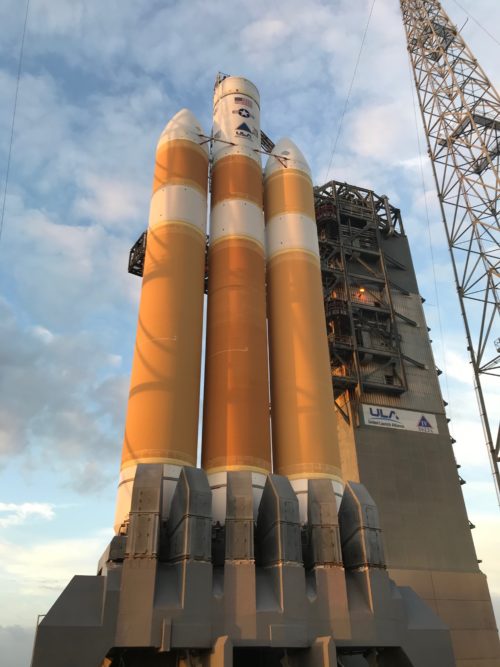
This will be the first voyage of a Delta in over a year, since the last member of the Delta IV Medium+ fleet launched into well-deserved retirement in August 2019. Flown 11 times between December 2004 and January of last year, the Delta IV Heavy was until the maiden voyage of SpaceX’s Falcon Heavy the most powerful rocket in active operational service, anywhere in the world.
Capable of lifting up to 57,280 pounds (25,980 kg) to low-Earth orbit and 31,350 pounds (14,220 kg) to geostationary altitude, it has previously launched seven major reconnaissance payloads for the NRO and one Defense Support Program (DSP) infrared early-warning sentinel, together with the Exploration Flight Test (EFT)-1 of NASA’s Orion spacecraft in December 2014 and, two years ago, the Parker Solar Probe.
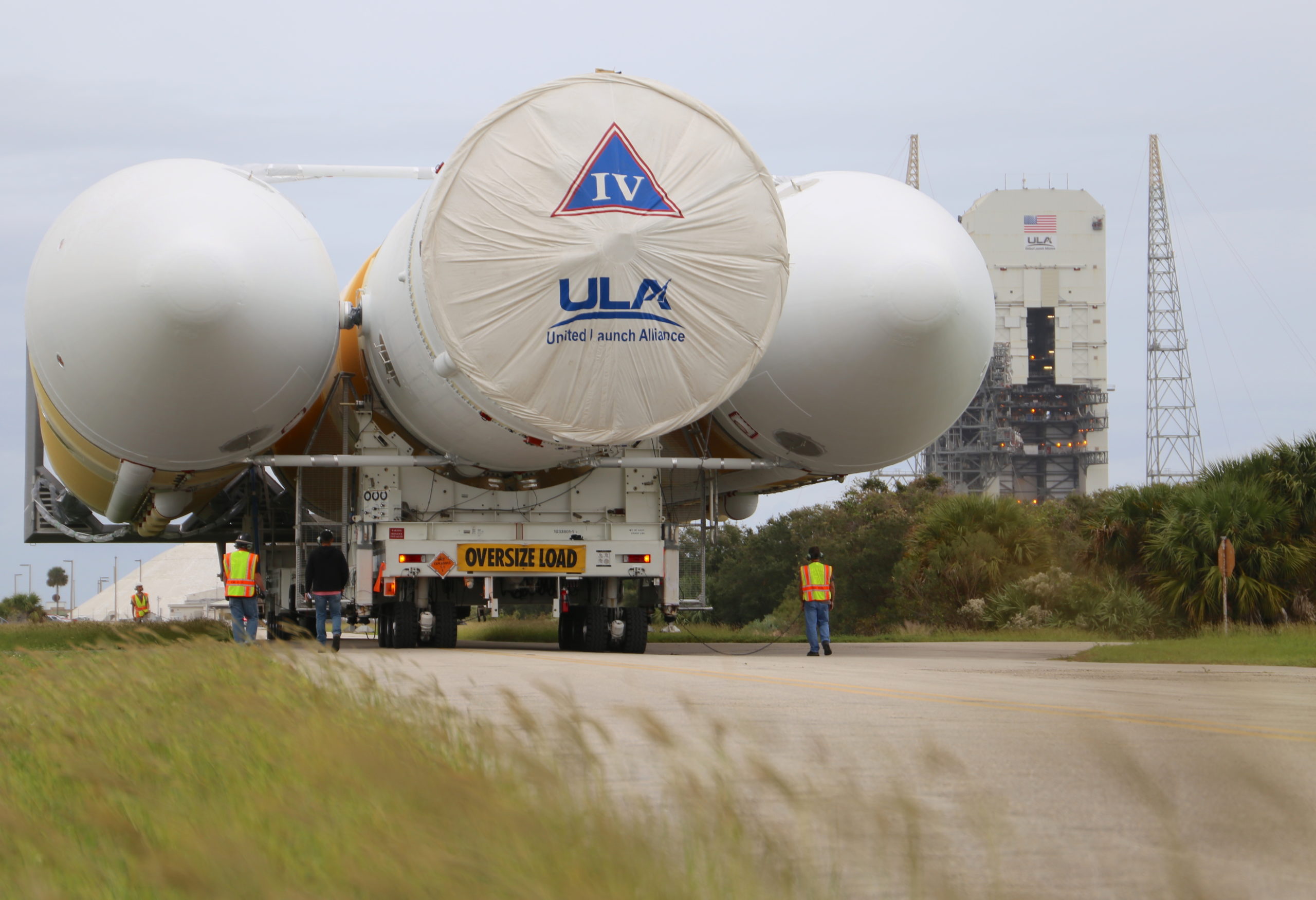
The three Common Booster Cores (CBCs) and Delta Cryogenic Second Stage (DCSS) for the mission arrived in Florida last summer and in November the 170-foot-tall (51.8-meter) Delta IV Heavy—minus her payload fairing—was rolled from the Horizontal Integration Facility (HIF) to the pad atop a 36-wheel, diesel-powered transporter and raised to the vertical. Systems testing filled the next few weeks and on 10 January the Delta IV Heavy was put through a WDR which involving loading all three CBCs with liquid oxygen and hydrogen and counting down through the Terminal Count to a cutoff at T-10 seconds.
With today’s installation of the payload fairing bearing NROL-44, the Delta IV Heavy stands some 235 feet (71.6 meters). Liftoff is presently targeted for no sooner than 26 August, having previously been delayed since June for undisclosed reasons.




